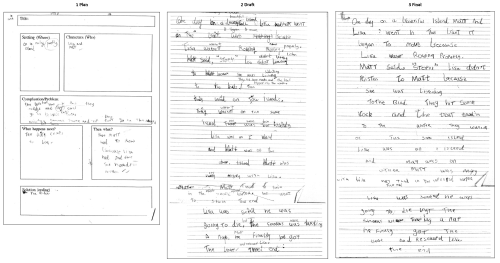Student information
The student was born in Australia and speaks Somali as their home language. They began Foundation in Victoria and are currently in Year 2.
Task
The students have been learning about narratives and have read a range of texts in the genre. They have been learning explicitly about the structure and linguistic features of a narrative and have participated in joint constructions of narratives with the teacher. The teacher has modelled how to develop a writing plan for narratives.
The analysis is based on the student’s draft before correction.

Text
one day on a biutyfall Lisa and Matt went in the boet was moveing because Lisa wasent Rowing PRoPley.
matt said, “STOP!!” Lisa dident lisening to matt because sne was listenting to the birds. Then thay laned on tow islands.
Thay wasent on the same island. Theee was tow islands Lisa was on 1 island and matt was on the other islend matt was vary angey with Lisa.
Matt thaot to swim in the shark water. he went to swim the end
Lisa was scerd he was going to die. The sharks was takeing A nap he finaley he got The boat
The end
This sample of student work demonstrates that the student can:
- Demonstrate understanding that handwritten texts usually need to be planned, edited and presented (VCEALA143)
- Make a simple plan before writing (VCEALL150)
- Show interest in patterns of spelling (VCEALA147)
- Use a variety of simple text structures (VCEALL149)
- Write sustained texts using sentences based on simple repetitive, modelled patterns (VCEALL151)
- Write sentences and phrases that reflect simple written-like structures (VCEALL152)
- Use a small range of basic verb forms accurately (VCEALL154)
- Use high-frequency words encountered in classroom activities (VCEALL155)
- Spell with accuracy familiar words and words with common letter patterns (VCEALL159)*uses letter sounds to spell unfamiliar words
Possible next steps for this student's learning
- Publishing their writing according to writing conventions, for example, writing on the lines and aligning text to the left (VCEALA144)
- Using adjectives and expanded noun groups to elaborate on characters and setting (VCEALL153)
- Using capital letters and full stops appropriately (VCEALL158)
- Understanding the meaning of different common punctuations and using them consistently in writing (VCEALL158)
- Learning about and applying spelling patterns when writing (VCEALL159)
Pathways and transitions considerations
A Year 2 student who is working within the range of A2 in any one language mode is not ready to transition to the English curriculum regardless of their proficiency in the other two language modes. This student will continue on Pathway A of the EAL curriculum in all language modes.
A Year 2 student should consistently demonstrate the final achievement standard in Pathway A (Level A2) in all three language modes before they transition to the English curriculum.
They will need to be equally capable across all three language modes to be able to meet the learning expectations in the English curriculum at the level taught to their mainstream peers, and without substantial language support.
They will need to be sufficiently proficient in understanding and using the academic language across the learning areas to participate in learning activities across the Victorian curriculum.
They will also need to be able to understand and use the academic English of the curriculum in subsequent years without substantial language support, when the cognitive and linguistic demands of the Victorian curriculum increase, for example in Year 3 and 4.
The teacher may also exercise their professional judgement to place the student on Pathway B of the EAL curriculum rather than transitioning them to the English curriculum. The teacher reviews the student’s language proficiency across the Victorian curriculum learning areas and determine where the student is best placed on Pathway B in each of the three language modes. The student will then start on Pathway B of the EAL curriculum in all language modes.